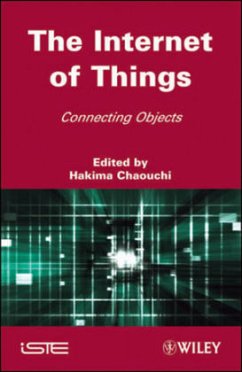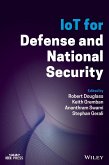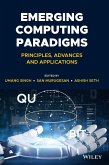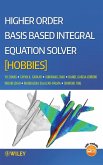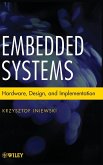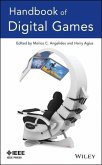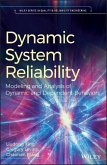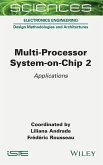The Internet of Things
Connecting Objects to the Web
Herausgegeben von Chaouchi, Hakima
The Internet of Things
Connecting Objects to the Web
Herausgegeben von Chaouchi, Hakima
- Gebundenes Buch
- Merkliste
- Auf die Merkliste
- Bewerten Bewerten
- Teilen
- Produkt teilen
- Produkterinnerung
- Produkterinnerung
Internet of Things: Connecting Objects... puts forward the technologies and the networking architectures which make it possible to support the Internet of Things. Amongst these technologies, RFID, sensor and PLC technologies are described and a clear view on how they enable the Internet of Things is given. This book also provides a good overview of the main issues facing the Internet of Things such as the issues of privacy and security, application and usage, and standardization.
Andere Kunden interessierten sich auch für
![Iot for Defense and National Security Iot for Defense and National Security]() DouglassIot for Defense and National Security119,99 €
DouglassIot for Defense and National Security119,99 €![Emerging Computing Paradigms Emerging Computing Paradigms]() Emerging Computing Paradigms109,99 €
Emerging Computing Paradigms109,99 €![Higher Order Basis Based Integral Equation Solver (Hobbies) Higher Order Basis Based Integral Equation Solver (Hobbies)]() Tapan K. SarkarHigher Order Basis Based Integral Equation Solver (Hobbies)214,99 €
Tapan K. SarkarHigher Order Basis Based Integral Equation Solver (Hobbies)214,99 €![Embedded Systems Embedded Systems]() Krzysztof IniewskiEmbedded Systems142,99 €
Krzysztof IniewskiEmbedded Systems142,99 €![Handbook of Digital Games Handbook of Digital Games]() Handbook of Digital Games144,99 €
Handbook of Digital Games144,99 €![Dynamic System Reliability Dynamic System Reliability]() Liudong XingDynamic System Reliability113,99 €
Liudong XingDynamic System Reliability113,99 €![Multi-Processor System-On-Chip 2 Multi-Processor System-On-Chip 2]() L AndradeMulti-Processor System-On-Chip 2144,99 €
L AndradeMulti-Processor System-On-Chip 2144,99 €-
-
-
Internet of Things: Connecting Objects... puts forward the technologies and the networking architectures which make it possible to support the Internet of Things. Amongst these technologies, RFID, sensor and PLC technologies are described and a clear view on how they enable the Internet of Things is given. This book also provides a good overview of the main issues facing the Internet of Things such as the issues of privacy and security, application and usage, and standardization.
Produktdetails
- Produktdetails
- Verlag: Wiley & Sons
- 1. Auflage
- Seitenzahl: 265
- Erscheinungstermin: 14. Juni 2010
- Englisch
- Abmessung: 242mm x 164mm x 24mm
- Gewicht: 554g
- ISBN-13: 9781848211407
- ISBN-10: 1848211406
- Artikelnr.: 28707918
- Herstellerkennzeichnung
- Libri GmbH
- Europaallee 1
- 36244 Bad Hersfeld
- gpsr@libri.de
- Verlag: Wiley & Sons
- 1. Auflage
- Seitenzahl: 265
- Erscheinungstermin: 14. Juni 2010
- Englisch
- Abmessung: 242mm x 164mm x 24mm
- Gewicht: 554g
- ISBN-13: 9781848211407
- ISBN-10: 1848211406
- Artikelnr.: 28707918
- Herstellerkennzeichnung
- Libri GmbH
- Europaallee 1
- 36244 Bad Hersfeld
- gpsr@libri.de
Olivier Hersent, Consultant, France. David Boswarthick, ETSI, France. Omar Elloumi, Alcatel-Lucent, France.
Preface xi
Chapter 1. Introduction to the Internet of Things 1
Hakima CHAOUCHI
1.1. Introduction 1
1.2. History of IoT 3
1.3. About objects/things in the IoT 7
1.4. The identifier in the IoT 9
1.5. Enabling technologies of IoT 13
1.6. About the Internet in IoT 21
1.7. Bibliography 32
Chapter 2. Radio Frequency Identification Technology Overview 35
Ayyangar Ranganath HARISH
2.1. Introduction 35
2.2. Principle of RFID 36
2.3. Components of an RFID system 41
2.4. Issues 48
2.5. Bibliography 52
Chapter 3. Wireless Sensor Networks: Technology Overview 53
Thomas WATTEYNE and Kristofer S.J. PISTER
3.1. History and context 53
3.2. The node 60
3.3. Connecting nodes 64
3.4. Networking nodes 70
3.5. Securing communication 88
3.6. Standards and Fora 89
3.7. Conclusion 91
3.8. Bibliography 91
Chapter 4. Power Line Communication Technology Overview 97
Xavier CARCELLE and Thomas BOURGEAU
4.1. Introduction 97
4.2. Overview of existing PLC technologies and standards 98
4.3. Architectures for home network applications 114
4.4. Internet of things using PLC technology 120
4.5. Conclusion 127
4.6. Bibliography 127
Chapter 5. RFID Applications and Related Research Issues 129
Oscar BOTERO and Hakima CHAOUCHI
5.1. Introduction 129
5.2. Concepts and terminology 129
5.3. RFID applications 139
5.4. Ongoing research projects 144
5.5. Summary and conclusions 152
5.6. Bibliography 153
Chapter 6. RFID Deployment for Location and Mobility Management on the
Internet 157
Apostolia PAPAPOSTOLOU and Hakima CHAOUCHI
6.1. Introduction 157
6.2. Background and related work 159
6.3. Localization and handover management relying on RFID 169
6.4. Technology considerations 176
6.5. Performance evaluation 181
6.6. Summary and conclusions 187
6.7. Bibliography 188
Chapter 7. The Internet of Things - Setting the Standards 191
Keith MAINWARING and Lara SRIVASTAVA
7.1. Introduction 191
7.2. Standardizing the IoT 193
7.3. Exploiting the potential of RFID 196
7.4. Identification in the IoT 202
7.5. Promoting ubiquitous networking: any where, any when, any what 212
7.6. Safeguarding data and consumer privacy 217
7.7. Conclusions 220
7.8. Bibliography 220
Chapter 8. Governance of the Internet of Things 223
Rolf H. WEBER
8.1. Introduction 223
8.2. Bodies subject to governing principles 225
8.3. Substantive principles for IoT governance 233
8.4. IoT infrastructure governance 239
8.5. Further governance issues 246
8.6. Outlook 248
8.7. Bibliography 248
Conclusion 251
List of Authors 261
Index 263
Chapter 1. Introduction to the Internet of Things 1
Hakima CHAOUCHI
1.1. Introduction 1
1.2. History of IoT 3
1.3. About objects/things in the IoT 7
1.4. The identifier in the IoT 9
1.5. Enabling technologies of IoT 13
1.6. About the Internet in IoT 21
1.7. Bibliography 32
Chapter 2. Radio Frequency Identification Technology Overview 35
Ayyangar Ranganath HARISH
2.1. Introduction 35
2.2. Principle of RFID 36
2.3. Components of an RFID system 41
2.4. Issues 48
2.5. Bibliography 52
Chapter 3. Wireless Sensor Networks: Technology Overview 53
Thomas WATTEYNE and Kristofer S.J. PISTER
3.1. History and context 53
3.2. The node 60
3.3. Connecting nodes 64
3.4. Networking nodes 70
3.5. Securing communication 88
3.6. Standards and Fora 89
3.7. Conclusion 91
3.8. Bibliography 91
Chapter 4. Power Line Communication Technology Overview 97
Xavier CARCELLE and Thomas BOURGEAU
4.1. Introduction 97
4.2. Overview of existing PLC technologies and standards 98
4.3. Architectures for home network applications 114
4.4. Internet of things using PLC technology 120
4.5. Conclusion 127
4.6. Bibliography 127
Chapter 5. RFID Applications and Related Research Issues 129
Oscar BOTERO and Hakima CHAOUCHI
5.1. Introduction 129
5.2. Concepts and terminology 129
5.3. RFID applications 139
5.4. Ongoing research projects 144
5.5. Summary and conclusions 152
5.6. Bibliography 153
Chapter 6. RFID Deployment for Location and Mobility Management on the
Internet 157
Apostolia PAPAPOSTOLOU and Hakima CHAOUCHI
6.1. Introduction 157
6.2. Background and related work 159
6.3. Localization and handover management relying on RFID 169
6.4. Technology considerations 176
6.5. Performance evaluation 181
6.6. Summary and conclusions 187
6.7. Bibliography 188
Chapter 7. The Internet of Things - Setting the Standards 191
Keith MAINWARING and Lara SRIVASTAVA
7.1. Introduction 191
7.2. Standardizing the IoT 193
7.3. Exploiting the potential of RFID 196
7.4. Identification in the IoT 202
7.5. Promoting ubiquitous networking: any where, any when, any what 212
7.6. Safeguarding data and consumer privacy 217
7.7. Conclusions 220
7.8. Bibliography 220
Chapter 8. Governance of the Internet of Things 223
Rolf H. WEBER
8.1. Introduction 223
8.2. Bodies subject to governing principles 225
8.3. Substantive principles for IoT governance 233
8.4. IoT infrastructure governance 239
8.5. Further governance issues 246
8.6. Outlook 248
8.7. Bibliography 248
Conclusion 251
List of Authors 261
Index 263
Preface xi
Chapter 1. Introduction to the Internet of Things 1
Hakima CHAOUCHI
1.1. Introduction 1
1.2. History of IoT 3
1.3. About objects/things in the IoT 7
1.4. The identifier in the IoT 9
1.5. Enabling technologies of IoT 13
1.6. About the Internet in IoT 21
1.7. Bibliography 32
Chapter 2. Radio Frequency Identification Technology Overview 35
Ayyangar Ranganath HARISH
2.1. Introduction 35
2.2. Principle of RFID 36
2.3. Components of an RFID system 41
2.4. Issues 48
2.5. Bibliography 52
Chapter 3. Wireless Sensor Networks: Technology Overview 53
Thomas WATTEYNE and Kristofer S.J. PISTER
3.1. History and context 53
3.2. The node 60
3.3. Connecting nodes 64
3.4. Networking nodes 70
3.5. Securing communication 88
3.6. Standards and Fora 89
3.7. Conclusion 91
3.8. Bibliography 91
Chapter 4. Power Line Communication Technology Overview 97
Xavier CARCELLE and Thomas BOURGEAU
4.1. Introduction 97
4.2. Overview of existing PLC technologies and standards 98
4.3. Architectures for home network applications 114
4.4. Internet of things using PLC technology 120
4.5. Conclusion 127
4.6. Bibliography 127
Chapter 5. RFID Applications and Related Research Issues 129
Oscar BOTERO and Hakima CHAOUCHI
5.1. Introduction 129
5.2. Concepts and terminology 129
5.3. RFID applications 139
5.4. Ongoing research projects 144
5.5. Summary and conclusions 152
5.6. Bibliography 153
Chapter 6. RFID Deployment for Location and Mobility Management on the
Internet 157
Apostolia PAPAPOSTOLOU and Hakima CHAOUCHI
6.1. Introduction 157
6.2. Background and related work 159
6.3. Localization and handover management relying on RFID 169
6.4. Technology considerations 176
6.5. Performance evaluation 181
6.6. Summary and conclusions 187
6.7. Bibliography 188
Chapter 7. The Internet of Things - Setting the Standards 191
Keith MAINWARING and Lara SRIVASTAVA
7.1. Introduction 191
7.2. Standardizing the IoT 193
7.3. Exploiting the potential of RFID 196
7.4. Identification in the IoT 202
7.5. Promoting ubiquitous networking: any where, any when, any what 212
7.6. Safeguarding data and consumer privacy 217
7.7. Conclusions 220
7.8. Bibliography 220
Chapter 8. Governance of the Internet of Things 223
Rolf H. WEBER
8.1. Introduction 223
8.2. Bodies subject to governing principles 225
8.3. Substantive principles for IoT governance 233
8.4. IoT infrastructure governance 239
8.5. Further governance issues 246
8.6. Outlook 248
8.7. Bibliography 248
Conclusion 251
List of Authors 261
Index 263
Chapter 1. Introduction to the Internet of Things 1
Hakima CHAOUCHI
1.1. Introduction 1
1.2. History of IoT 3
1.3. About objects/things in the IoT 7
1.4. The identifier in the IoT 9
1.5. Enabling technologies of IoT 13
1.6. About the Internet in IoT 21
1.7. Bibliography 32
Chapter 2. Radio Frequency Identification Technology Overview 35
Ayyangar Ranganath HARISH
2.1. Introduction 35
2.2. Principle of RFID 36
2.3. Components of an RFID system 41
2.4. Issues 48
2.5. Bibliography 52
Chapter 3. Wireless Sensor Networks: Technology Overview 53
Thomas WATTEYNE and Kristofer S.J. PISTER
3.1. History and context 53
3.2. The node 60
3.3. Connecting nodes 64
3.4. Networking nodes 70
3.5. Securing communication 88
3.6. Standards and Fora 89
3.7. Conclusion 91
3.8. Bibliography 91
Chapter 4. Power Line Communication Technology Overview 97
Xavier CARCELLE and Thomas BOURGEAU
4.1. Introduction 97
4.2. Overview of existing PLC technologies and standards 98
4.3. Architectures for home network applications 114
4.4. Internet of things using PLC technology 120
4.5. Conclusion 127
4.6. Bibliography 127
Chapter 5. RFID Applications and Related Research Issues 129
Oscar BOTERO and Hakima CHAOUCHI
5.1. Introduction 129
5.2. Concepts and terminology 129
5.3. RFID applications 139
5.4. Ongoing research projects 144
5.5. Summary and conclusions 152
5.6. Bibliography 153
Chapter 6. RFID Deployment for Location and Mobility Management on the
Internet 157
Apostolia PAPAPOSTOLOU and Hakima CHAOUCHI
6.1. Introduction 157
6.2. Background and related work 159
6.3. Localization and handover management relying on RFID 169
6.4. Technology considerations 176
6.5. Performance evaluation 181
6.6. Summary and conclusions 187
6.7. Bibliography 188
Chapter 7. The Internet of Things - Setting the Standards 191
Keith MAINWARING and Lara SRIVASTAVA
7.1. Introduction 191
7.2. Standardizing the IoT 193
7.3. Exploiting the potential of RFID 196
7.4. Identification in the IoT 202
7.5. Promoting ubiquitous networking: any where, any when, any what 212
7.6. Safeguarding data and consumer privacy 217
7.7. Conclusions 220
7.8. Bibliography 220
Chapter 8. Governance of the Internet of Things 223
Rolf H. WEBER
8.1. Introduction 223
8.2. Bodies subject to governing principles 225
8.3. Substantive principles for IoT governance 233
8.4. IoT infrastructure governance 239
8.5. Further governance issues 246
8.6. Outlook 248
8.7. Bibliography 248
Conclusion 251
List of Authors 261
Index 263

